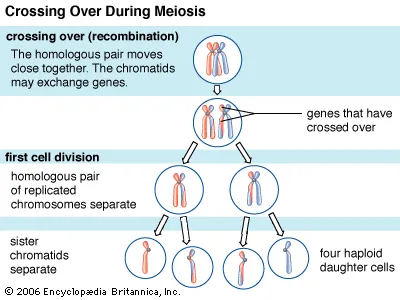Meiosis, the splitting of cells that result in genetic variation and are exclusively for our sex cells.
- Sperm cells for males and ovum for females; these are the sex cells
Haploid Gametes
All somatic (body) cells in multicellular organisms are genetically identical due to mitosis
- All descended from a zygote
Zygote forms when two haploid/gametes fuse; gametes are genetically different because they are formed from mitosis
Haploid: 1 copy of each chromosome (chromosomes 1-23), and diploid means that there are 2 copies of each chromosome
During cell division, only 1 chromosome from each homologous (same) pair is copied; results in only 23 cells.
Meiosis
Gametes are from cell division called meiosis
- This produces 4 daughter cells and results iin diversity and variation (all daughter cells rae haploids)
- Quite different from mitosis, in that there is crossing over and independent assortment
- Crossing over: when the chromosomes line up in the middle, they swap over a bit of genetic information, which cause variation
- Independent Assortment: In meiosis I, one chromosome from each pair goes to one of the cells while the other goes to another; this is completely random

Meiosis I
- Homologous pairs of chromosomes align in the middle of the parent cell and are separated
- Cell divides so each new daughter cells only contain one chromosome from each pair; 23 in total
- Introduces genetic diversity by randomly dividing a cell’s genes into 2; results in 2 haploid cells
Meiosis II
- Chromosomes align and its chromatids are moved to opposite ends
- Splits each chromosome into 2 chromatids and places 1 in each cell
- Results in 4 unique haploid genes
IPMAT for Mieiosis (there are 2 phases of this)
Prophase I
- DNA turns to chromosomes after each one duplicates (the two separate parts of the chromosome are called sister chromatids)
Metaphase I
- Chromosomes align at centre
- Crossing over and independent assortment here
Anaphase I
- Separate with sister chromatids remain together (the chromosome pair splits up; with one chromosome going one way and the other (they don’t break/actually split this time))
Telophase I
- Two daughter cells formed with each only containing one chromosome from the pair
Prophase II
- DNA condenses into chromosomes
Metaphase II
- Chromosomes line up (again)
Anaphase II
- Divide and sister chromatids move to each pole; this time the chromosomes actually break and divide into 2
- Like in mitosis
Telophae II
- Cell splits into 2 daughter cells (this happens to both of the cells) so 4 haploid cells in total are produced
BASICALLY THE SAME AS IPMAT BUT WITH CROSSING OVER AND INDEPENDENT ASSORTMENT

